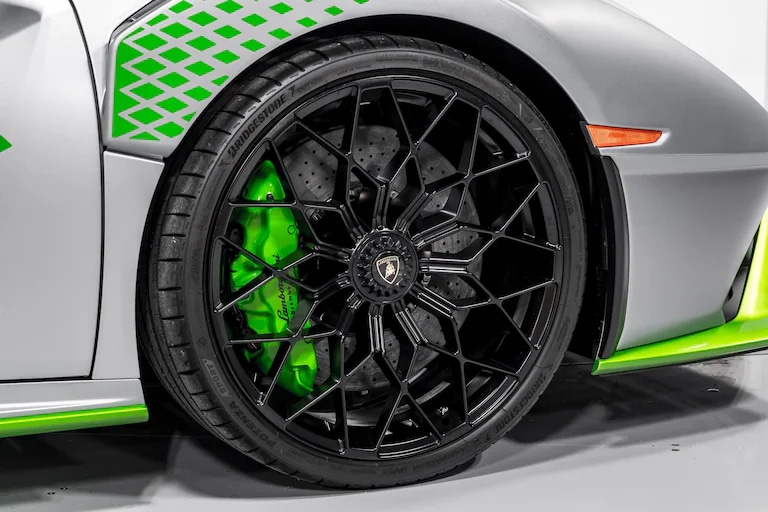
When it comes to supercars and high-performance vehicles, stopping power is just as important as acceleration. That’s where carbon-ceramic brakes come in. These high-tech braking systems are found in nearly every exotic car, from Ferraris and Lamborghinis to McLarens and Porsches. But why do supercars use carbon-ceramic brakes, and what’s the best way to maintain them?
What Are Carbon-Ceramic Brakes?
Carbon-ceramic brakes (CCBs) are made from carbon fiber reinforced with ceramic compounds, rather than traditional iron or steel. This advanced material was originally developed for aerospace and motorsports applications due to its exceptional heat resistance and durability.
These brakes can be identified by their larger rotors, distinctive appearance, and often brightly colored calipers (e.g., Lamborghini’s yellow or Ferrari’s red).
Why Do Supercars Use Carbon-Ceramic Brakes?
1. Superior Heat Resistance
Supercars generate extreme amounts of heat under braking, especially on the track. Unlike traditional steel brakes, which can overheat and fade, carbon-ceramic brakes withstand temperatures over 1,800°F (1,000°C) without losing stopping power.
Example: The McLaren P1’s braking system is designed to handle intense heat from 200+ mph speeds without fading.
2. Exceptional Stopping Power
Carbon-ceramic brakes provide stronger and more consistent braking performance than steel brakes, even under extreme conditions. This is critical for supercars, which need to slow down quickly from high speeds.
Example: A Ferrari SF90 Stradale can go from 60 to 0 mph in under 95 feet, thanks in part to its advanced carbon-ceramic braking system.
3. Lightweight Design for Better Performance
CCBs are significantly lighter than traditional steel brakes, reducing unsprung weight (the weight of parts not supported by the suspension, like wheels and brakes). Less weight improves:
- Acceleration
- Handling
- Fuel efficiency
Example: The Lamborghini Huracán Performante benefits from lighter brakes, allowing for sharper cornering and better lap times.
4. Long Lifespan and Durability
Unlike traditional steel brakes, which wear out relatively quickly, carbon-ceramic brakes can last up to 100,000 miles in regular driving conditions. They don’t corrode or rust, making them ideal for long-term performance.
Example: Porsche’s optional PCCB (Porsche Ceramic Composite Brakes) are designed to last significantly longer than steel brakes under normal street use.
5. Low Brake Dust and Corrosion Resistance
Carbon-ceramic brakes produce less brake dust, which helps keep wheels cleaner and prevents corrosion. This is especially beneficial for exotic cars with high-end alloy or carbon-fiber wheels.
Example: Owners of McLaren, Ferrari, or Bugatti vehicles with multi-spoke or lightweight wheels appreciate carbon-ceramic brakes for their ability to keep wheels clean.
How to Maintain Carbon-Ceramic Brakes
While carbon-ceramic brakes offer exceptional performance, they also require proper maintenance to keep them in peak condition. Here’s how to care for them:
1. Avoid Excessive Low-Speed Braking
CCBs work best at higher temperatures. Frequent low-speed braking (such as in stop-and-go traffic) can cause uneven wear and lead to noise or reduced performance.
Best Practice: Occasionally perform a few moderate-speed braking events (50 mph → 10 mph) to keep the rotors clean and in good condition.
2. Be Cautious When Driving in Cold or Wet Conditions
Carbon-ceramic brakes need to warm up to perform at their best. In cold or wet conditions, they may have slightly reduced braking performance until they reach optimal temperature.
Best Practice: Give the brakes time to warm up before hard braking in cold weather.
3. Never Use Harsh Chemical Cleaners on Rotors
Avoid using harsh wheel cleaners or direct pressure washing on the rotors. Chemicals and excess moisture can negatively affect the braking surface.
Best Practice: Use a soft cloth and mild soap to clean the brake calipers, and allow the brakes to air dry naturally.
4. Follow the Manufacturer’s Brake Pad Recommendations
Carbon-ceramic rotors last a long time, but brake pads still wear out. Always use OEM (Original Equipment Manufacturer) pads designed specifically for carbon-ceramic brakes.
Using incorrect pads can damage the rotors, which are extremely expensive to replace.
Best Practice: Have your brakes inspected regularly at a certified exotic car service center.
5. Be Mindful of Track Use
While carbon-ceramic brakes are great for track use, repeated aggressive braking from high speeds can still cause wear. If you track your car often, monitor your brake pad thickness and rotor condition regularly.
Best Practice: After a track day, drive the car gently for 10–15 minutes to allow the brakes to cool down gradually.
Are Carbon-Ceramic Brakes Worth It?
For daily drivers, carbon-ceramic brakes may not always be necessary, especially considering the high cost of replacement parts. However, for high-performance driving, track use, and long-term durability, they are absolutely worth the investment.
Cost Consideration: While carbon-ceramic brakes are more expensive upfront, their longer lifespan and low maintenance needs often justify the cost for supercar owners.